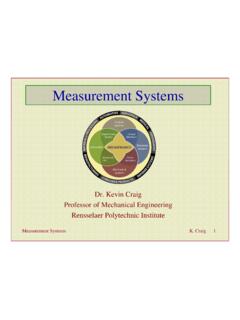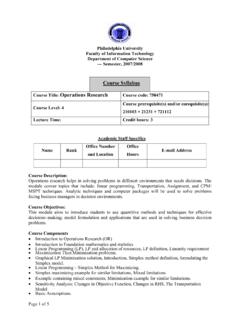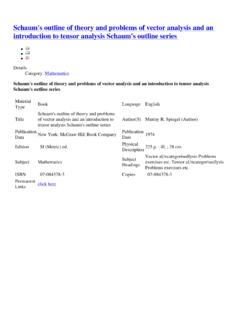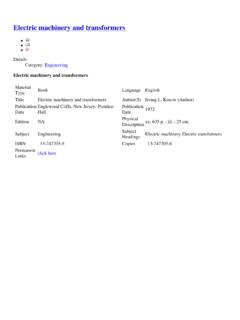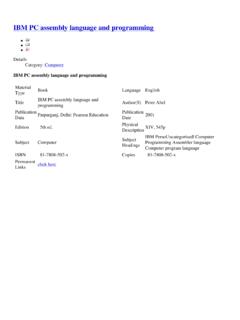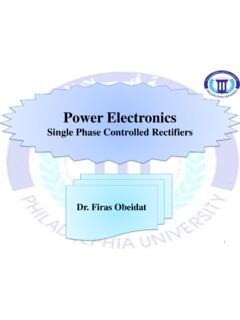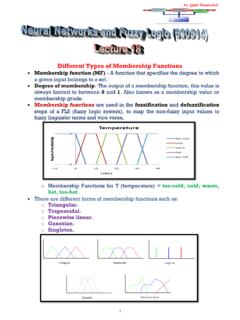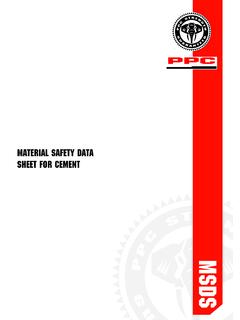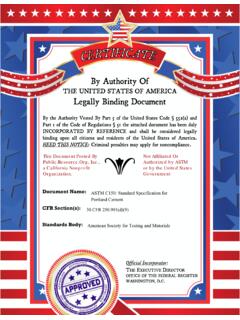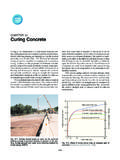Transcription of Portland Cement, Concrete, Volume 18/Number 2 and Heat …
1 Portland cement Association Portland cement , Concrete, Volume 18/Number 2. and Heat of Hydration July 1997. When Portland cement is mixed demonstrates the effect of 5420 Old Orchard Road with water, heat is liberated. This element size on concrete tempera- heat is called the heat of hydration, ture with time due to the heat of Skokie, Illinois 60077-1083 the result of the exothermic chemical hydration. reaction between cement and water. Temperature rises of 55 C (100 F). Phone: (847) 966-6200 The heat generated by the cement 's have been observed with high ce- hydration raises the temperature of ment content mixes.(2) These tem- Fax: (847) 966-8389. concrete. perature rises cause expansion while Web Site: During normal concrete construc- the concrete is hardening. If the tem- tion, the heat is dissipated into the perature rise is significantly high soil or the air and resulting tempera- and the concrete undergoes nonuni- Contents ture changes within the structure are form or rapid cooling, stresses due not significant.
2 However, in some to thermal contraction in conjunction situations, particularly in massive with structural restraint can result in structures, such as dams, mat foun- cracking before or after the concrete Portland cement , Concrete, and the Heat of Hydration dations, or any element more than eventually cools to the surrounding about a meter or yard thick, the heat temperature. Contractors often insu- can not be readily released. The late massive elements to control tem- cement on the Go mass concrete may then attain high perature changes. As a rule of internal temperatures, especially thumb, the maximum temperature during hot weather construction, or differential between the interior and if high cement contents are used. exterior concrete should not exceed 50. cement content 360 kg/m3 (605 lb/yd3). 40 Formwork, 18-mm-thick plywood ( in) 110.
3 Temperature taken at center of wall Temperature, C. Temperature, F. Ambient temperature, 5 C (41 F). 30 * Wall thickness, mm (in.) 90. 1000. 20 30 50 (40) 70. 0( 0( 700 *. Continuing Studies of 12 20 (27. ) ) 5). Concrete in Sulfate Soils 10 50. Reinforcement News 0 32. 0 2 4 6 8 10 12 14. New Literature Time (days). Fig. 1. Effect of member thickness on temperature of concrete. Reference 1. R e t u r n To I n d e x Concrete Technology Today 20 C (36 F) to avoid crack develop- 120. types (average = cal/g at 7 days) B B. ment .(3) The potential for thermal and Type IV has the lowest (average = B. B. 100. cracking is dependent on the Heat of hydration, cal/g cal/g at 7 days). B. concrete's tensile strength, coeffi- Portland cement evolves heat for a 80 B. cient of thermal expansion, tempera- long time.(4) Reference 4 and Fig.
4 2. ture difference within the concrete, present heat of hydration data out to 60 B. and restraint on the member. 13 years. Fig. 2 shows that the rate of Concrete placed in cold conditions heat generation is greatest at early 40 Type I cement benefits from the heat generated by ages. Usually, the greatest rate of heat W/C = cement hydration, helping protect it liberation occurs within the first 24 20 Cured at 21 C (70 F). from freezing and providing a more hours and a large amount of heat favorable curing temperature. Adding evolves within the first 3 days. For 0. insulation to the formwork helps trap most concrete elements, such as pave- 1 10 100 1000 10000. the heat in the concrete, allowing it to Time, days (log scale). ments, long-term heat generation is achieve the required strength. not a concern as this heat is dissipated Fig.
5 2. Average heat of into the environment. hydration of a Type I cement at Heat of Hydration of various ages to 13 years. Portland Cements Factors Affecting Reference 4. The heat of hydration of cement is Heat of Hydration heat, and at a faster rate, than usually determined in accordance Materials can be selected to minimize dicalcium silicate or other cement with ASTM C 186, Standard Test or maximize the heat of hydration, de- compounds. Sulfate content, in its Method for Heat of Hydration of Hy- pending on the need. Cements with relation to controlling the hydra- draulic cement (see box). Table 1 has higher contents of tricalcium silicate tion of calcium aluminate, partici- heat of hydration values for a vari- and tricalcium aluminate, as well as a pates in the rate of heat liberation. ety of Portland cements from 1992 to higher fineness, such as Type III ce- Higher fineness provides a 1996.
6 Although this data is very lim- ments, have higher rates of heat gen- greater surface area to be wetted, ited, it confirms the general trends eration than other cements. resulting in an acceleration of the expected: Type III cement has higher Tricalcium silicate and tricalcium reaction between cement and wa- heat of hydration than other cement aluminate chemically generate more ter. This causes an increase in the Table 1. ASTM C 186 Heat of hydration for selected Portland cements, calories per gram*. Type I cement Type II cement Type II Type III cement Type IV cement Type V. (moderate cement heat) cement No. 7 day 28 day No. 7 day 28 day No. 7 day No. 7 day 28 day No. 7 day 28 day No. 7 day 1 ** 16 32 36 38 41 2 17 33 37 39 42 3 18 34 40 43 4 19 35 44 5 20 45 6 21 46 7 22 8 23 . 9 24 10 25 11 26 12 27 . 13 28 . 14 29 . 15 30.
7 31 . Avg. Avg. Avg. Avg. Avg. NM. Avg. Max. Max. Max. Max. NM Max. NM NM. Max. Min. Min. Min. Min. NM. Min. NM NM. Min. % of *% of table is based on limited data provided by various testing laboratories and cement companies. The cements were This Type I. Type testedI between 100 1992 and 1996. 99 75 106 67 89. (7 day ** No data available. (7day). avg.). NM: not meaningful. 1 cal/g = kJ/kg 2. R e t u r n To I n d e x July 1997. Tests for Heat of Hydration dry cement heat of solution and the ture (for example, by a thermo- Two methods of determining the heat capacity of the container, the electric device). Water is added heat of hydration are commonly heat of hydration for the desired hy- and the energy required to main- used. ASTM C 186, Standard Test drating period can be calculated. tain the sample temperature is Method for Heat of Hydration of Hy- Samples can be hydrated any length continuously recorded.
8 By integra- draulic cement , uses a heat of solu- of time with this technique. tion, the heat of hydration at any tion procedure. In this test, a The other common method is con- time can be obtained; however, sample is dissolved in an acid so- duction calorimetry. In this non- the length of the test is usually lution inside a well-insulated con- standard procedure, a sample of ce- limited to 3 days as the rate of tainer and the temperature rise is ment is placed in a conductive con- heat evolution becomes too low to recorded. After correction for the tainer and kept at a specific tempera- measure beyond that time period. rate of heat liberation at early ages, tures that retard hydration delay should be specified, but not both. but may not influence the total heat development. Mineral admix- ASTM C 595, Standard Specification amount of heat developed over sev- tures, such as fly ash, can signifi- for Blended Hydraulic Cements, and eral weeks.
9 Cantly reduce the rate and amount of ASTM C 1157, Standard Performance Other factors influencing heat de- heat development. Specification for Blended Hydraulic Ce- velopment in concrete include the ment , both provide the option of cement content, water- cement ratio, Specifications for specifying moderate- and low-heat placing and curing temperature, the Reduced Heat Cements of hydration cements using physical presence of mineral and chemical limits. For moderate heat of hydra- admixtures, and the dimensions of When heat generation must be mini- tion, C 595 adds the suffix MH to the the structural element. mized in concrete, one way to cement type, calling out limits of 70. In general, higher cement contents achieve this is to choose a lower heat calories per gram (290 kJ/kg) at 7. result in more heat development. ACI cement , such as a Type II cement days and 80 calories per gram (330.)
10 , Standard Practice for Selecting with the optional moderate heat of kJ/kg) at 28 days, while C 1157 (ce- Proportions for Normal, Heavyweight, hydration requirements. Not all ment Type MH) has limits of 70 calo- and Mass Concrete, states that as a Type II cements are made for a mod- ries per gram (290 kJ/kg) at 7 days rough guide, hydration of cement will erate level of heat development, as the only requirement. For low generate a concrete temperature rise however, so the moderate heat op- heat of hydration, both C 595 (LH. of about C to C per 50 kg of tion must be specifically required suffix) and C 1157 (Type LH ) have cement per m3 of concrete (10 F to (see Table 1). Type IV, low heat of limits of 60 calories per gram (250. 15 F per 100 lb of cement per yd3 of hydration cement , can also be used kJ/kg) at 7 days and 70 calories per concrete) in 18 to 72 hours.
